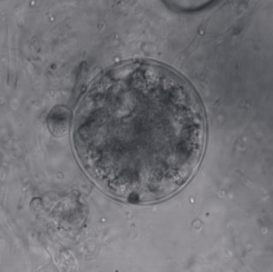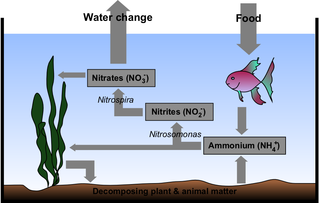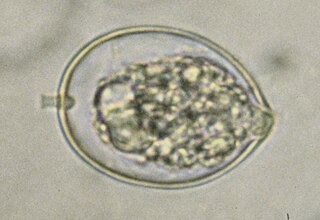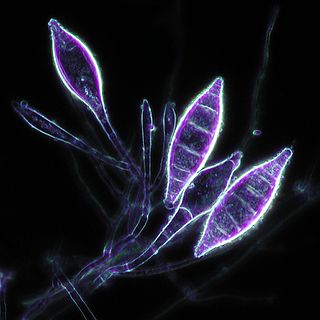Saprolegnia is a genus of water moulds often called cotton moulds because of the characteristic white or grey fibrous patches they form. Current taxonomy puts Saprolegnia as a genus of the heterokonts in the order Saprolegniales.
Saprolegnia is a genus of water moulds often called cotton moulds because of the characteristic white or grey fibrous patches they form. Current taxonomy puts Saprolegnia as a genus of the heterokonts in the order Saprolegniales.
Saprolegnia, like most oomycetes, is both a saprotroph and necrotroph. Typically feeding on waste from fish or other dead cells, they will also take advantage of creatures that have been injured. An infection is known as oomycosis.
Saprolegnia is tolerant to a wide range of temperature, 3–33 °C (37–91 °F), but is more prevalent in lower temperatures. While it is found most frequently in freshwater, it will also tolerate brackish water and even moist soil.
Saprolegnia filaments (hyphae) are long with rounded ends, containing the zoospores. Saprolegnia generally travels in colonies consisting of one or more species. They first form a mass of individual hyphae. When the mass of hyphae grows large enough in size to be seen without use of a microscope, it can be called a mycelium. Colonies are generally white in color, though they may turn grey under the presence of bacteria or other debris which has become caught in the fibrous mass.
It has a diploid life cycle which includes both sexual and asexual reproduction. In the asexual phase, a spore of Saprolegnia releases zoospores. Within a few minutes, this zoospore will encyst, germinate and release another zoospore. This second zoospore has a longer cycle during which most dispersal happens; it will continue to encyst and release a new spore in a process called polyplanetism until it finds a suitable substrate. When a suitable medium is located, the hairs surrounding the spore will lock onto the substrate so that the sexual reproduction phase can start. It is also during this stage of polyplanetism that the Saprolegnia are capable of causing infection; the most pathogenic species have tiny hooks at the end of their hairs to enhance their infectious ability.
Once firmly attached, sexual reproduction begins with the production of male and female gametangium, antheridia and oogonium respectively. These unite and fuse together via fertilization tubes. The zygote produced is named an oospore.
Saprolegnia is generally a secondary pathogen, though in the right circumstances, it can act as primary. It most frequently targets fish, both in the wild and in tank environments. Through necrosis of the skin, Saprolegnia will spread across the surface of its host as a cotton-like film. Though it often stays in the epidermal layers, the mould does not appear to be tissue specific. A Saprolegnia infection is usually fatal, eventually causing hemodilution, though the time to death varies depending on the initial site of the infection, rate of growth and the ability of the organism to withstand the stress of the infection.
The extensive mortalities of salmon and migratory trout in the rivers of western Europe in the 1970s and 1980s in the UDN outbreak were probably almost all ultimately caused by the secondary Saprolegnia infections.
Historical evidence suggest the Saprolegnia species affecting Australian freshwater fish may be an introduced strain, imported in the 1800s with exotic salmonid species.

Ascomycota is a phylum of the kingdom Fungi that, together with the Basidiomycota, forms the subkingdom Dikarya. Its members are commonly known as the sac fungi or ascomycetes. It is the largest phylum of Fungi, with over 64,000 species. The defining feature of this fungal group is the "ascus", a microscopic sexual structure in which nonmotile spores, called ascospores, are formed. However, some species of the Ascomycota are asexual, meaning that they do not have a sexual cycle and thus do not form asci or ascospores. Familiar examples of sac fungi include morels, truffles, brewers' and bakers' yeast, dead man's fingers, and cup fungi. The fungal symbionts in the majority of lichens such as Cladonia belong to the Ascomycota.

Chytridiomycota are a division of zoosporic organisms in the kingdom Fungi, informally known as chytrids. The name is derived from the Ancient Greek χυτρίδιον, meaning "little pot", describing the structure containing unreleased zoospores. Chytrids are one of the earliest diverging fungal lineages, and their membership in kingdom Fungi is demonstrated with chitin cell walls, a posterior whiplash flagellum, absorptive nutrition, use of glycogen as an energy storage compound, and synthesis of lysine by the α-amino adipic acid (AAA) pathway.

The Oomycetes, or Oomycota, form a distinct phylogenetic lineage of fungus-like eukaryotic microorganisms within the Stramenopiles. They are filamentous and heterotrophic, and can reproduce both sexually and asexually. Sexual reproduction of an oospore is the result of contact between hyphae of male antheridia and female oogonia; these spores can overwinter and are known as resting spores. Asexual reproduction involves the formation of chlamydospores and sporangia, producing motile zoospores. Oomycetes occupy both saprophytic and pathogenic lifestyles, and include some of the most notorious pathogens of plants, causing devastating diseases such as late blight of potato and sudden oak death. One oomycete, the mycoparasite Pythium oligandrum, is used for biocontrol, attacking plant pathogenic fungi. The oomycetes are also often referred to as water molds, although the water-preferring nature which led to that name is not true of most species, which are terrestrial pathogens.

The Mucorales is the largest and best-studied order of zygomycete fungi. Members of this order are sometimes called pin molds. The term mucormycosis is now preferred for infections caused by molds belonging to the order Mucorales.
Phytophthora sojae is an oomycete and a soil-borne plant pathogen that causes stem and root rot of soybean. This is a prevalent disease in most soybean growing regions, and a major cause of crop loss. In wet conditions the pathogen produces zoospores that move in water and are attracted to soybean roots. Zoospores can attach to roots, germinate, and infect the plant tissues. Diseased roots develop lesions that may spread up the stem and eventually kill the entire plant. Phytophthora sojae also produces oospores that can remain dormant in the soil over the winter, or longer, and germinate when conditions are favourable. Oospores may also be spread by animals or machinery.

Mucor is a microbial genus of approximately 40 species of molds in the family Mucoraceae. Species are commonly found in soil, digestive systems, plant surfaces, some cheeses like Tomme de Savoie, rotten vegetable matter and iron oxide residue in the biosorption process.

Ornamental fish kept in aquariums are susceptible to numerous diseases. Due to their generally small size and the low cost of replacing diseased or dead fish, the cost of testing and treating diseases is often seen as more trouble than the value of the fish.
Sporogenesis is the production of spores in biology. The term is also used to refer to the process of reproduction via spores. Reproductive spores were found to be formed in eukaryotic organisms, such as plants, algae and fungi, during their normal reproductive life cycle. Dormant spores are formed, for example by certain fungi and algae, primarily in response to unfavorable growing conditions. Most eukaryotic spores are haploid and form through cell division, though some types are diploid sor dikaryons and form through cell fusion.we can also say this type of reproduction as single pollination
In botany, a zoid or zoïd is a reproductive cell that possesses one or more flagella, and is capable of independent movement. Zoid can refer to either an asexually reproductive spore or a sexually reproductive gamete. In sexually reproductive gametes, zoids can be either male or female depending on the species. For example, some brown alga (Phaeophyceae) reproduce by producing multi-flagellated male and female gametes that recombine to form the diploid sporangia. Zoids are primarily found in some protists, diatoms, green alga, brown alga, non-vascular plants, and a few vascular plants. The most common classification group that produces zoids is the heterokonts or stramenopiles. These include green alga, brown alga, oomycetes, and some protists. The term is generally not used to describe motile, flagellated sperm found in animals. Zoid is also commonly confused for zooid which is a single organism that is part of a colonial animal.

Phytophthora cactorum is a fungal-like plant pathogen belonging to the Oomycota phylum. It is the causal agent of root rot on rhododendron and many other species, as well as leather rot of strawberries.

Phytophthora medicaginis is an oomycete plant pathogen that causes root rot in alfalfa and chickpea. It is a major disease of these plants and is found wherever they are grown. P. medicaginis causes failure of stand establishment because of seedling death. Phytophthora medicaginis is part of a species complex with Phytophthora megasperma.
Phytophthora nicotianae or black shank is an oomycete belonging to the order Peronosporales and family Peronosporaceae.
Pythium irregulare is a soil borne oomycete plant pathogen. Oomycetes, also known as "water molds", are fungal-like protists. They are fungal-like because of their similar life cycles, but differ in that the resting stage is diploid, they have coenocytic hyphae, a larger genome, cellulose in their cell walls instead of chitin, and contain zoospores and oospores.
Pythium aphanidermatum is a soil borne plant pathogen. Pythium is a genus in the class Oomycetes, which are also known as water molds. Oomycetes are not true fungi, as their cell walls are made of cellulose instead of chitin, they are diploid in their vegetative state, and they form coenocytic hyphae. Also, they reproduce asexually with motile biflagelette zoospores that require water to move towards and infect a host. Sexually, they reproduce with structures called antheridia, oogonia, and oospores.
Albugo occidentalis, the causal agent of spinach white rust, is an oomycete plant pathogen, although some discussions still treat it as a fungal organism. Albugo occidentalis is one of the most important spinach diseases in North America, found throughout the United States east of the rocky mountains.

Phycomycetes is an obsolete polyphyletic taxon for certain fungi with aseptate hyphae. It is used in the Engler system. Asexual reproduction takes place by zoospores (motile) or by Aplanospores (non-motile). These spores are endogenously produced in sporangium. A zygospore is formed by fusion of two gametes. These gametes are similar in morphology (isogamous) or dissimilar.

Microsporum canis is a pathogenic, asexual fungus in the phylum Ascomycota that infects the upper, dead layers of skin on domesticated cats, and occasionally dogs and humans. The species has a worldwide distribution.
Achlya bisexualis is a species of water mold. It is described as being close to Achlya flagellata, differing by it striking heterothallism and less elongated gemmae.
Globisporangium sylvaticum is a plant pathogen, an oomycete known to cause root rot and damping off in a multitude of species. These species include apples, carrot, cherry laurel, cress, cucumber, garlic, lettuce, pea, rhododendron, and spinach. Symptoms of infection include stunting, wilt, chlorosis, and browning and eventual necrosis of roots. The pathogen can by identified by the presence of thick, microscopic, round spores within the cells of the root.

This glossary of mycology is a list of definitions of terms and concepts relevant to mycology, the study of fungi. Terms in common with other fields, if repeated here, generally focus on their mycology-specific meaning. Related terms can be found in glossary of biology and glossary of botany, among others. List of Latin and Greek words commonly used in systematic names and Botanical Latin may also be relevant, although some prefixes and suffixes very common in mycology are repeated here for clarity.